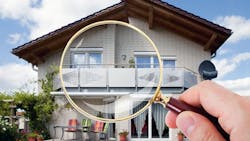A Performance Evaluation of an HVAC Inspection Report
This morning I received an HVAC inspection report from one of my sons. He and his wife have purchased a twenty-year-old home. Being a good and faithful son of an HVAC guy, he was sure to have the HVAC systems inspected and share the results with his dad, inviting comments and recommendations. May I share with you what I saw as I reviewed the 12-page report?
What was Included and What’s Missing
Let’s see what was included in the report. After each section, I will provide some suggestions about what the report could have included that appeared to be missing. Granted this is an “inspection report” but the big question is; what else should be added to increase the value and use of these reports for the home buyer or any of your current customers?
If you offer HVAC Inspection Reports as one of your services, perhaps you’ll discover a few opportunities to expand your offerings to customers. Woven into this article are components of what HVAC inspections reports will look like in the future.
The Intent of the Report
After reading the report, I did my best to understand its intent. I struggled to discover what point the contractor/inspector intended to reach beyond making a few minor repairs. It seems he followed a pre-determined format and just filled in the blanks.
The report listed cataloged generic data about the systems and building. It cost was about $500 and included summary information about the five HVAC systems in the home. I would say that 25% of the report content was photos.
I reduced the value of the report to the overwhelming question that most contractors can barely answer; Is the system working? Unfortunately, the answer -- that most contractors barely qualify to offer -- is a simple yes or no.
Here lies the real shortcoming of this report. The answer given was “Yes, the systems are working.” But is that really the answer a home buyer is expecting? I don’t think so.
What was missing? The report contained no conclusions that could help the homeowner form an opinion on the condition, shortcomings, or expectations of how each HVAC system was operating. There wasn’t enough information in the report that would help new homeowners make any decisions about upcoming equipment replacement. Since the systems are 20 years old, that would certainly be of value. The report made no mention that the equipment was at the end of its life. The report also contained no utility cost information to help assess the cost of operating the systems.
Bottom line, the information a home buyer needs to make a decision about the HVAC systems they were buying was completely absent from the report. Basically, the intent of the report was to capture nameplate and building data, and include a few photographs that also failed to educate the new buyers. Whoopty doo!
What WAS in the Report
The report contained some very basic building information. This included the age of the home, the direction the entrance faced, the ambient temperature outdoors, location of the equipment, and that the home is owner-occupied.
It then provided some basic observations about the HVAC systems Including manufacturer and model numbers, type of systems installed (gas heating, forced air), filters present., The report said the systems had sufficient combustion air and the coil, thermostats, and refrigerant lines were all “satisfactory.” There was no reference to any industry standards or the assessment method used to determine what this meant.
It did include a few photographs to add more pages to the report. I had a hard time telling what the pictures were trying to describe.
That is about it. All fluff, no meat or substance any home buyer or homeowner could use. I think we can do better.
What was missing? Focusing on the fact that this may be a typical inspection report is not the point of the article. So, let’s look beyond the traditional inspection report and see what a valuable report may contain that really serves our customers.
Suggested content upgrades to add to the report include:
-More specifics and less generic observations are needed to guide the home buyer to useful conclusions.
-An overall assessment of the expected life of the existing equipment. Remember, these are 20-year-old systems and there was no mention of planning for replacement.
-Clear language use that any customers can understand. In this report, the description of the photos consisted of three or four words that were near meaningless to the prospective buyers. HVAC technical jargon was used throughout the report. You cannot expect a customer to understand this type of language.
-Include actual system performance measurements. In this report, not a single measurement was recorded to prove any of the conclusions about the systems in the home. “If you don’t measure you’re just guessing.” The level of performance of an installed HVAC system can be field measured and scored by a trained technician. This would provide documentation of the installed system efficiency.
Defects Found and Recommendations
What motivation drives a home buyer to purchase an HVAC inspection report? The hope is that the report provides an assessment of and insight into the remaining life of each system. It should also provide homeowners an understanding of how well systems are working, what repairs are needed, and why it’s important to perform recommended repairs.
The existing report did highlight the following defects contained found with the five HVAC systems:
1. The humidifier on the lower north system is leaking, some rust detected.
2. A general observation that they are monitored on an ongoing basis due to age.
3. The condenser fins are dirty – all units.
4. Systems 2 and 5 have noisy compressors.
5. Unit 4 is low on refrigerant.
The only recommendation included in the report was “Have systems serviced.”
What was missing? Once again, let's look beyond the industry norm (if this report represents the industry norm) and consider what could be added to increase the worth of such a report to a homeowner or home buyer.
Suggested upgrades to the content of the report include:
• Describe each of the needed repairs in terms a home buyer can understand. This would answer the question of why repairs should be made. What if you just told your customer to make a repair without explaining why? They would throw you out of the house.
• Explain how the defect impacts the system and what benefits are gained if repairs are made. Also explain what pitfalls are avoided if repairs are not made.
If your company is engaged in offering inspection services with reporting to your customers, please consider upgrading the content of your reports to increase the usefulness and value of what you offer. More value increases the worth of your reports.
Avoid being held back by antiquated, fill-in-the-blank reports used by the home inspection industry. You may choose to start offering a premium level of HVAC system assessment and getting the training needed to improve the value of your services.
Rob “Doc” Falke serves the industry as president of National Comfort Institute, Inc. -- an HVAC-based training company and membership organization. If you're an HVAC contractor or technician interested in a free report about performance testing, contact Doc at [email protected] or call him at 800-633-7058. Go to NCI’s website at nationalcomfortinstitute.com for free information, articles, and downloads.
About the Author
Rob 'Doc' Falke
President
Rob “Doc” Falke serves the industry as president of National Comfort Institute an HVAC-based training company and membership organization. If you're an HVAC contractor or technician interested in a building pressure measurement procedure, contact Doc at [email protected] or call him at 800-633-7058. Go to NCI’s website at NationalComfortInstitute.com for free information, articles and downloads.

